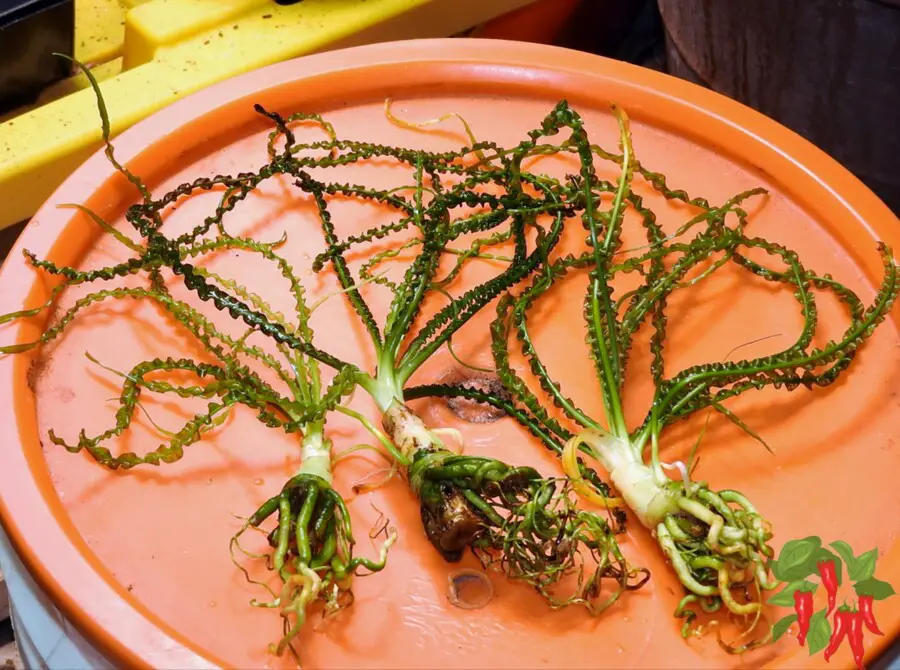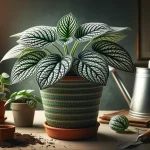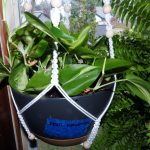This post may contain affiliate links. If you buy something from one of our links we may earn a commission. Thanks

Aquarium setups can start to feel a little “same old, same old.” But right in the middle of your tank, Crinum calamistratum the African Onion Plant brings a twist—literally!
With wild, curly leaves and a bold look, it’s a plant that makes your tank stand out without being high maintenance.
Crinum calamistratum the African Onion Plant
Key Takeaways
- Crinum calamistratum the African Onion Plant is a freshwater aquarium plant known for its long, curly leaves and striking appearance.
- It thrives in large tanks with low to medium light and soft water.
- Plant it with the bulb partly exposed.
- It’s a low-maintenance choice perfect for backgrounds or bold centerpiece designs in aquascapes.
🌿 Introduction: Crinum calamistratum African Onion Plant: A Stunning Twist
Not every aquarium plant turns heads, but Crinum calamistratum the African Onion Plant does it with a twist—literally.
Known for its long, curly leaves and bulb-like base, this beauty adds motion and mystery to your tank.
In this guide, you’ll learn how to plant it right, help it thrive, and use it to transform your aquascape.
🧬 What Is Crinum calamistratum?
Crinum calamistratum is a freshwater aquarium plant like no other. Nicknamed the African Onion Plant or Twisted Crinum, it’s famous for its long, curly leaves that ripple in the water like green ribbons.
Native to Cameroon, this plant brings a wild, untamed look to any tank—without being a hassle to grow.
🌍 Quick Facts at a Glance:
- Common Names: African Onion Plant, Twisted Crinum
- Scientific Name: Crinum calamistratum
- Origin: Central Africa (Cameroon)
- Plant Type: Bulb-forming aquatic plant
- Water Type: Freshwater
- Leaf Shape: Long, narrow, and naturally curled
- Best Placement: Background or large centerpiece in big tanks
This plant isn’t just decorative—it’s a conversation starter with attitude.
Crinum calamistratum – Wikipedia
🛠️ Crinum calamistratum Care Guide
Caring for Crinum calamistratum is surprisingly simple, especially for such a show-stopping plant.
Whether you’re a beginner or a seasoned aquascaper, this plant adds elegance without demanding constant attention.
Here’s what you need to know to keep it happy and thriving.
🐠 Tank Conditions
- 🌿 Best for large tanks — 20 gallons or more
- 🪴 Ideal placement — Background or bold centerpiece
- 💡 Light needs — Low to medium light tolerated
- 💧 Water type — Soft to moderately hard water
🌡️ Water Parameters
- 🌡️ Temperature: 72–82°F (room temp to tropical)
- ⚖️ pH range: 6.0 to 8.0
- 💨 CO₂: Optional but enhances color and growth
💡 Lighting Tips
- ✅ Grows well under standard aquarium lights
- 🔆 Stronger light encourages faster growth and richer green leaves
- ❌ Avoid placing under floating plants that block too much light
Set it up right, and Crinum calamistratum will reward you with slow but steady growth and graceful, waving foliage.
Crinum calamistratum Plant Care Reference Guide
| Characteristic | Details |
|---|---|
| Common Name | African Onion Plant, Twisted Crinum |
| Botanical Name | Crinum calamistratum |
| Native Habitat | Cameroon, Central Africa |
| Plant Type | Freshwater bulb plant |
| Growth Pattern | Slow-growing, long curly leaves |
| Mature Size | Up to 4 feet wide, 20–48 inch leaves |
| Watering | Aquatic—fully submerged with exposed bulb |
| Light/Sun Exposure | Low to medium aquarium light |
| Soil Type | Fine gravel or sand (aquarium substrate) |
| Soil pH | 6.0–8.0 |
| Temperature | 72–82°F |
| Humidity | Fully aquatic, humidity not a factor |
| Bloom Time & Flower Color | Occasional white, lily-like flowers |
| Potential Problems | Bulb rot if fully buried; slow growth |
| Repotting | Rarely needed; may propagate via daughter bulbs |
| Hardiness Zones (USDA) | Aquarium only (not rated for outdoor zones) |
🌱 How To Plant Crinum calamistratum
Planting Crinum calamistratum isn’t complicated, but it’s important to get it right from the start.
This bulb plant needs just a little breathing room to thrive. If you plant it too deep, it may rot before it even gets going.
Here’s how to set it up for long-term success.
🪴 Planting Tips for Success
- 🌰 Don’t bury the bulb — Keep the top half above the substrate
- 🏝️ Best substrates — Fine gravel or aquarium sand
- 🧱 Ideal placement — Back corners or behind driftwood or rock
- ☁️ Avoid shade — Keep it away from heavy floating plants that block light
This method gives the bulb airflow and lets the long curly leaves flow freely, perfect for creating that signature wild look.
✂️ Trimming and Maintenance Tips
Once Crinum calamistratum gets going, it’s mostly a hands-off plant. But when those curly leaves start to crowd your tank or get a little too long, a light touch goes a long way.
Here’s how to keep it healthy without hurting its natural shape.
🧼 Maintenance Guidelines
- ❌ Don’t cut leaves halfway — This can cause dieback or rot
- ✅ Remove full leaves from the base — Always trim at the bottom
- 🪴 Rarely needs pruning — Proper spacing helps avoid overcrowding
- 🧹 Gently remove old or damaged leaves — No tugging or tearing
A little cleanup now and then is all this plant needs to keep looking fresh and flowing beautifully.
📏 How Big Does Crinum calamistratum Get?
Crinum calamistratum might start off small, but don’t be fooled. It’s a slow starter with big ambitions.
Once it settles in, it spreads out with long, flowing leaves that can easily take over the back half of your tank if left unchecked.
📐 Size and Growth Details
- 🌿 Leaf length: Up to 48–78 inches in ideal conditions
- ↔️ Spread: Grows wide—needs plenty of open space
- 🐢 Growth rate: Slow at first, faster once rooted and stable
- 🔁 Tank role: Works best in the background or as a flowing centerpiece
Plan ahead and give it room. It does not do well when it’s moved. It’s a statement plant that thrives when it’s not cramped.
🌸 Will It Flower? Crinum calamistratum Bloom Info
While Crinum calamistratum is mostly grown for its dramatic leaves, it can surprise you with a beautiful bloom.
Under the right conditions, this aquatic stunner produces elegant, lily-like white flowers that rise above the leaves, a rare treat in freshwater tanks.
🌼 Flowering Facts
- 🤍 Flower type: White, lily-like blossoms
- 🕰️ Timing: Most likely to bloom in mature, stable aquariums
- 💡 Requirements: Strong lighting and consistent water parameters
- 🌿 Bonus: Flowers add vertical interest and a delicate fragrance (outside water)
If your tank is dialed in, a Crinum bloom is like a high-five from nature—beautiful and well-earned.
🌱 Propagation: Is It Possible?
You won’t be propagating Crinum calamistratum every weekend—but it can be done if you’re patient.
This plant grows from a bulb and may eventually produce smaller bulbs, or “pups,” that can be used to start new plants.
🔁 Propagation Tips
- 🌰 Bulb-based growth — Not a stem or rhizome propagator
- 👶 Daughter bulbs — Appear over time as the plant matures
- ✂️ Separate carefully — Detach pups once they’re a decent size
- 🌿 Replant properly — Keep half the bulb exposed above the substrate
It’s a slow process, but if your tank conditions are right, you’ll get a free encore plant down the road.
🐟 African Onion Plant Aquarium Use
Looking to add texture and movement to your aquascape? The African Onion Plant (Crinum calamistratum) delivers just that, wavy, twisting leaves that sway with the current and bring your tank to life.
It’s a natural fit for planted setups that lean toward the wild and organic look.
🧭 Why It Works in Aquariums
- 🌊 Great for natural aquascapes — Adds a wild, untamed look
- 🐠 Fish- and shrimp-safe — Leaves aren’t usually nibbled
- 🎋 Creates motion — Long leaves flow gently with water movement
- 🌿 Pairs well with:
- Anubias
- Java Fern
- Bucephalandra
- Bolbitis
Use it as a background anchor or a flowing focal point—it holds its own without stealing the show.
🛒 Crinum calamistratum for Sale: What To Know Before Buying
Before you bring home a Crinum calamistratum, you’ll want to make sure you’re getting a healthy plant that’s ready to thrive.
Whether you’re shopping online or in-store, a quick check can save you from bulb rot or disappointment down the line.
🛍️ What to Look For
- ✅ Firm, healthy bulb — The base should be solid, not soft or squishy
- ❌ Avoid fully submerged bulbs — These often rot during shipping
- 🔍 Look for signs of life — Even a small sprout is a good sign
- 🌱 Leaf color: Healthy plants may already have light green curly leaves starting to unfurl
🛒 Where to Buy
- 🛒 Online retailers:
- Canton Aquatics
- Amazon
- eBay
- 🪴 Local aquarium shops: Ask if they carry African Onion Plant for sale
With the right pick, you’ll have a showpiece plant that can last for years in your aquascape.
🧅 Bonus: Is It Really an Onion?
Despite the name, Crinum calamistratum isn’t part of your dinner salad. The nickname African Onion Plant comes from its bulbous base and, yes, its faint onion-like smell if damaged.
But don’t worry, it’s not related to actual onions and it definitely doesn’t flavor your tank!
🧠 Fun Facts About the Name
- ❌ Not a true onion — No culinary connection
- 🌰 Has a bulb — Similar in shape to onion varieties
- 👃 Mild scent — Crushed or damaged bulbs can release an oniony smell
- 🪴 Name comes from appearance — Not taste or botanical family
It’s all style, no tears—just a quirky name for one seriously cool plant.
💯 My Experience: 3 Twisted Sisters from Canton Aquatics
When I first saw Crinum calamistratum listed at Canton Aquatics, I knew I had to give it a shot, so I ordered three.
Why three? Because I’ve got three tanks, and honestly, I couldn’t pick just one to put this beauty in.
Each plant came with its own little twist (literally), and I was instantly hooked.
🪴 First Impressions
- 🌱 Healthy bulbs with gorgeous curly leaves
- 🧼 Needed a quick rinse and substrate prep
- 🪴 Bulbs had to be planted halfway above the gravel
- ⚠️ Learned quickly: don’t clip the leaves halfway—remove from the base if needed
They’re now the stars of my setups. I placed each one in a back corner and let their leaves flow across the tank like green streamers. Super easy to care for, and they’re already settling in.
This plant really adds a twist—pun intended—to my aquascapes. Each tank looks wilder and more alive now.
🌟 Final Thoughts: Should You Try Crinum calamistratum?
If you’re looking to shake up your aquascape with something bold yet easygoing, Crinum calamistratum checks all the boxes.
It’s a fantastic choice for aquarists who enjoy plants with personality and don’t mind a bit of slow growth at first.
This is one of those plants that quietly takes over—in the best way possible.
💚 Why It Stands Out
- 🌿 Perfect for patient aquascapers — Slow and steady wins the tank
- 🎯 Striking as a background or focal point — Those flowing leaves steal the show
- 🧼 Low-maintenance — Once planted right, it mostly cares for itself
- 🌊 Unique energy — Great for tanks that feel a little too stiff or sterile
- 🪴 Pairs well with popular plants — Like Java Fern and Anubias
✅ Key Takeaways
- ✅ Don’t bury the bulb—leave it half above the substrate
- ✅ Great for medium to large aquariums with gentle flow
- ✅ Grows slowly but can reach 4+ feet wide
- ✅ Can produce elegant white flowers in stable setups
- ✅ Safe for fish and shrimp, adds dynamic motion
- ✅ May propagate through daughter bulbs with time
Whether you’re new to aquascaping or just looking to add something extraordinary, Crinum calamistratum the African Onion Plant brings a twist you’ll love watching grow.
Planted Aquariums: A Beginner’s Guide to Success
❓ FAQ: Crinum calamistratum Questions, Answered
Here’s a quick guide to the most common questions people ask about Crinum calamistratum the African Onion Plant.
Whether you’re planting it for the first time or watching it bloom, these answers will help you keep it thriving.
Q. How should I plant Crinum calamistratum?
A. Plant it with the bulb halfway above the substrate—burying it fully can cause rot.
Q. How big does Crinum calamistratum get?
A. The leaves can stretch up to 4 feet long, making it ideal for large tanks.
Q. Is it safe for fish and shrimp?
A. Yes! It’s totally aquarium-safe and even provides shelter for shy fish and baby shrimp.
Q. Can I trim the leaves?
A. Only remove full leaves at the base—don’t clip them halfway, or they may rot.
Q. Does it flower in aquariums?
A. Yes, under ideal conditions it can produce elegant white, lily-like flowers.
Q. How fast does Crinum calamistratum grow?
A. It starts slow but speeds up after a few months in stable conditions.
Q. Can I grow Crinum calamistratum in low light?
A. Yes, though it may grow slower and stay smaller in low-light tanks.
If you’re wondering whether it’s the right fit for your tank, it probably is. It’s hardy, beautiful, and brings a ton of visual interest with very little fuss.
Visit my Amazon Influencer Page for videos and gardening products Grow Your Own Garden






